Selected Publications
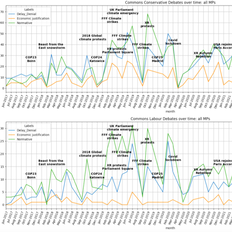
Climate Action or Delay: The Dynamics of Competing Narratives in the Political Sphere and their Drivers. 2024, Climate Policy in review, preprint on SSRN, with Nicole Nisbett, Cristina Leston-Bandeira, Daniel Valdenegro.
It is often argued that political will is needed to make progress on responding to the climate crisis. Political will needs a narrative though, substantiating why political intervention is needed. This paper examines the dynamics of three main competing climate policy narratives in the political sphere - normatively founded climate action, economically founded climate action and delay of climate action-, using data of parliamentary debates in the UK between 2017 and 2022 and interviews with policy-makers, for complementary computational, statistical and qualitative analyses. Moreover, we investigate the role played by external events, particularly climate protests, in shaping these competing dynamics. We find an increase in normative arguments for climate action in 2019 during major climate protests, which become the dominant argument line. And while this increase slowed down during the COVID-19 pandemic, it nevertheless continued. Analysis suggests moreover that the dynamic is self-reinforcing and that the normative and the denial dynamics seem to be closely coupled. We also find considerable differences between the two major UK parties. The governing Conservatives are becoming increasingly split between the climate action and climate delay camps, paralysing any policy progress and not displaying a clear dominant argumentation line, albeit latest dynamics suggest delay arguments becoming more dominant. Labour, on the other hand, is embracing normatively founded climate action, often mixed with economically founded climate action arguments, though even within Labour delay arguments are occasionally employed. Our interviews with policy-makers confirm our computational analysis: flagship UK climate policies would not have been possible without the pressure from climate protests, but later, more disruptive protests lost their effect on the policy-makers.
It is often argued that political will is needed to make progress on responding to the climate crisis. Political will needs a narrative though, substantiating why political intervention is needed. This paper examines the dynamics of three main competing climate policy narratives in the political sphere - normatively founded climate action, economically founded climate action and delay of climate action-, using data of parliamentary debates in the UK between 2017 and 2022 and interviews with policy-makers, for complementary computational, statistical and qualitative analyses. Moreover, we investigate the role played by external events, particularly climate protests, in shaping these competing dynamics. We find an increase in normative arguments for climate action in 2019 during major climate protests, which become the dominant argument line. And while this increase slowed down during the COVID-19 pandemic, it nevertheless continued. Analysis suggests moreover that the dynamic is self-reinforcing and that the normative and the denial dynamics seem to be closely coupled. We also find considerable differences between the two major UK parties. The governing Conservatives are becoming increasingly split between the climate action and climate delay camps, paralysing any policy progress and not displaying a clear dominant argumentation line, albeit latest dynamics suggest delay arguments becoming more dominant. Labour, on the other hand, is embracing normatively founded climate action, often mixed with economically founded climate action arguments, though even within Labour delay arguments are occasionally employed. Our interviews with policy-makers confirm our computational analysis: flagship UK climate policies would not have been possible without the pressure from climate protests, but later, more disruptive protests lost their effect on the policy-makers.
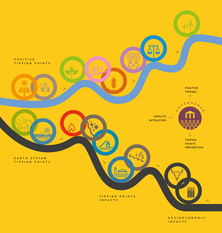
Global Tipping Points Report. 2023. edited by Tim M. Lenton, David J. Armstrong McKay, Sina Loriani, Jesse F. Abrams, Steve J. Lade, Jonathan F. Donges, Manjana Milkoreit, Tom Powell, Steven R. Smith, Caroline Zimm, Joshua E. Buxton, Emma Bailey, Laurie Laybourn, Ashish Ghadiali, James G. Dyke.
Harmful tipping points in the natural world pose some of the gravest threats faced by humanity. Their triggering will severely damage our planet’s life-support systems and threaten the stability of our societies. The report consists of four sections. Section one summarises our knowledge on climate and other Earth system tipping points. Section two summarises our knowledge on the potential impacts of breaching Earth system tipping points. This includes negative social tipping points and cascades, which in turn could further destabilise the Earth system. Section three investigates existing governance structures and comes to the conclusion that currently, there is no adequate global governance at the scale of the threats posed by negative tipping points. New governance mechanisms and structures are explored. Section four explores the potential of positive social tipping points and cascades that offer accelerated transformation pathways to avoid tipping the Earth system. The report summarises the state of the art but offers also a range of practical policy recommendations.
Harmful tipping points in the natural world pose some of the gravest threats faced by humanity. Their triggering will severely damage our planet’s life-support systems and threaten the stability of our societies. The report consists of four sections. Section one summarises our knowledge on climate and other Earth system tipping points. Section two summarises our knowledge on the potential impacts of breaching Earth system tipping points. This includes negative social tipping points and cascades, which in turn could further destabilise the Earth system. Section three investigates existing governance structures and comes to the conclusion that currently, there is no adequate global governance at the scale of the threats posed by negative tipping points. New governance mechanisms and structures are explored. Section four explores the potential of positive social tipping points and cascades that offer accelerated transformation pathways to avoid tipping the Earth system. The report summarises the state of the art but offers also a range of practical policy recommendations.
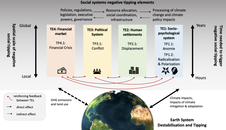
Negative Social Tipping Dynamics Resulting from and Reinforcing Earth System Destabilisation, 2023, Earth System Dynamics, in review preprint, with Sirkku Juhola, Sara M. Constantino, Weisi Guo, Tabitha Watson, Jana Sillmann, Alessandro Craparo, Ashleigh Basel, John T. Bruun, Krishna Krishnamurthy, Jürgen Scheffran, Patricia Pinho, Uche T. Okpara, Jonathan F. Donges, Avit Bhowmik, Taha Yasseri, Ricardo Safra de Campos, Graeme S. Cumming, Hugues Chenet, Florian Krampe, and Jesse F. Abrams
In recent years research on positive social tipping dynamics in response to the climate crisis has produced invaluable insights. In contrast, relatively little attention has been given to the potentially negative social dynamics that might arise due to an increasingly destabilised Earth system, and how they might in turn reinforce social destabilisation dynamics and/or impede positive social change. In this paper, we identify potential negative tipping elements linked to Earth System destabilisation and draw on related research to understand the drivers and likelihood of these negative tipping dynamics, their potential effects on human societies and the Earth system, and the potential for cascading interactions and contribution to systemic risks. This first attempt to provide a first explorative conceptualisation of negative social tipping dynamics is intended to motivate further research into an under-researched area that is nonetheless crucial for our ability to respond to the climate crisis and for ensuring that positive social tipping dynamics are not averted by negative ones.
In recent years research on positive social tipping dynamics in response to the climate crisis has produced invaluable insights. In contrast, relatively little attention has been given to the potentially negative social dynamics that might arise due to an increasingly destabilised Earth system, and how they might in turn reinforce social destabilisation dynamics and/or impede positive social change. In this paper, we identify potential negative tipping elements linked to Earth System destabilisation and draw on related research to understand the drivers and likelihood of these negative tipping dynamics, their potential effects on human societies and the Earth system, and the potential for cascading interactions and contribution to systemic risks. This first attempt to provide a first explorative conceptualisation of negative social tipping dynamics is intended to motivate further research into an under-researched area that is nonetheless crucial for our ability to respond to the climate crisis and for ensuring that positive social tipping dynamics are not averted by negative ones.
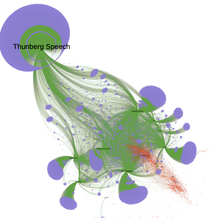
The Moral Power of Youth Climate Activists - Transforming International Climate Politics?, 2023, Global Environmental Change, 82, 102717, with Nicole Nisbett.
Youth Climate Activists are important norm entrepreneurs as humanity is increasingly awakening to the realities of accelerating climate change. They push for seeing climate change not merely through cost-benefit analysis frames but through frames of multiple climate justices. But how successful have these activists been in shifting perspectives in the context of international climate politics? This paper aims to investigate (1) to what extent the normative framework advanced by this movement is increasingly penetrating the international public climate debate, changing arguments, priorities, and frames around the annual UNFCCC COP conferences and (2) the key actors pushing for normative change. Using a unique and comprehensive Twitter dataset for the period between 2014 and 2021 revolving around the annual UNFCCC COP conferences and major youth climate protest events we combine various computational methods, including transformers-based topic modelling and social network analysis in this study. We find that indeed the normative framework advanced by the movement has successfully penetrated the discourse around UNFCCC and that youth climate activists were able gain support from central actors outside the movement, which is further contributing to the diffusion of their normative framework. We conclude that while these results demonstrate the moral power of youth climate activists, more research is needed to understand the influence on the actual negotiations outcomes.
Youth Climate Activists are important norm entrepreneurs as humanity is increasingly awakening to the realities of accelerating climate change. They push for seeing climate change not merely through cost-benefit analysis frames but through frames of multiple climate justices. But how successful have these activists been in shifting perspectives in the context of international climate politics? This paper aims to investigate (1) to what extent the normative framework advanced by this movement is increasingly penetrating the international public climate debate, changing arguments, priorities, and frames around the annual UNFCCC COP conferences and (2) the key actors pushing for normative change. Using a unique and comprehensive Twitter dataset for the period between 2014 and 2021 revolving around the annual UNFCCC COP conferences and major youth climate protest events we combine various computational methods, including transformers-based topic modelling and social network analysis in this study. We find that indeed the normative framework advanced by the movement has successfully penetrated the discourse around UNFCCC and that youth climate activists were able gain support from central actors outside the movement, which is further contributing to the diffusion of their normative framework. We conclude that while these results demonstrate the moral power of youth climate activists, more research is needed to understand the influence on the actual negotiations outcomes.
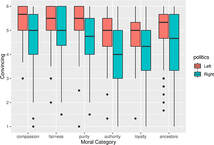
How convincing are AI-generated moral arguments for climate action?, 2023, Frontiers in Climate, 5, 1193350, with Nicole Nisbett.
Mobilizing broad support for climate action is paramount for solving the climate crisis. Research suggests that people can be persuaded to support climate action when presented with certain moral arguments, but which moral arguments are most convincing across the population? With this pilot study, we aim to understand which types of moral arguments based on an extended Moral Foundation Theory are most effective at convincing people to support climate action. Additionally, we explore to what extent Generative Pre-trained Transformer 3 (GPT-3) models can be employed to generate bespoke moral statements. We find statements appealing to compassion, fairness and good ancestors are the most convincing to participants across the population, including to participants, who identify as politically right-leaning and who otherwise respond least to moral arguments. Negative statements appear to be more convincing than positive ones. Statements appealing to other moral foundations can be convincing, but only to specific social groups. GPT-3-generated statements are generally more convincing than human-generated statements, but the large language model struggles with creating novel arguments.
Mobilizing broad support for climate action is paramount for solving the climate crisis. Research suggests that people can be persuaded to support climate action when presented with certain moral arguments, but which moral arguments are most convincing across the population? With this pilot study, we aim to understand which types of moral arguments based on an extended Moral Foundation Theory are most effective at convincing people to support climate action. Additionally, we explore to what extent Generative Pre-trained Transformer 3 (GPT-3) models can be employed to generate bespoke moral statements. We find statements appealing to compassion, fairness and good ancestors are the most convincing to participants across the population, including to participants, who identify as politically right-leaning and who otherwise respond least to moral arguments. Negative statements appear to be more convincing than positive ones. Statements appealing to other moral foundations can be convincing, but only to specific social groups. GPT-3-generated statements are generally more convincing than human-generated statements, but the large language model struggles with creating novel arguments.
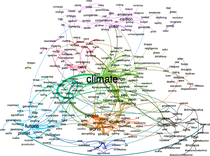
"How dare you?" - The Normative Challenge Posed by Fridays for Future , 2022, Viktoria Spaiser, Nicole Nisbett and Cristina Stefan, PLoS Climate, 1(10), e0000053.
Meeting the Paris Agreement will require unprecedented social change that goes hand in hand with technological and economic innovations. Research suggests that normative change, the change in what is perceived as normal or morally acceptable, can drive wider large-scale social change, i.e., change in legislation, policy, and behaviour. Normative change often starts with a normative challenge, i.e., practices considered normal, come to be seen as morally repugnant. In this paper we explore the normative challenge posed by Fridays for Future, analysing computationally a large data set of tweets in the context of this protest movement to understand the normative framework that challenges business as usual. We show that Friday for Future’s normative framework makes the shared, unjust casualty experience of young people because of the unmitigated climate crisis accessible to the public. The victims are now in spatial, temporal, and social proximity, they are our children and grandchildren, and this makes the normative challenge of the status quo (continuation of fossil-fuel based economy) so potent. The normative framework references human rights and duty of care when establishing an anti-fossil-fuel norm and prescribes solidarity with climate victims in the Global South, activism and seeking solutions that are based in science.
Meeting the Paris Agreement will require unprecedented social change that goes hand in hand with technological and economic innovations. Research suggests that normative change, the change in what is perceived as normal or morally acceptable, can drive wider large-scale social change, i.e., change in legislation, policy, and behaviour. Normative change often starts with a normative challenge, i.e., practices considered normal, come to be seen as morally repugnant. In this paper we explore the normative challenge posed by Fridays for Future, analysing computationally a large data set of tweets in the context of this protest movement to understand the normative framework that challenges business as usual. We show that Friday for Future’s normative framework makes the shared, unjust casualty experience of young people because of the unmitigated climate crisis accessible to the public. The victims are now in spatial, temporal, and social proximity, they are our children and grandchildren, and this makes the normative challenge of the status quo (continuation of fossil-fuel based economy) so potent. The normative framework references human rights and duty of care when establishing an anti-fossil-fuel norm and prescribes solidarity with climate victims in the Global South, activism and seeking solutions that are based in science.

Consumption-based accounting of CO2 emissions in the Sustainable Development Goals Agenda, 2019,
Viktoria Spaiser, Kate Scott, Anne Owen and Robert Holland, International Journal of Sustainable Development and World Ecology, 26(4), 282-289.
In 2017 the paper ‘The Sustainable Development Oxymoron: Quantifying and Modelling the Incompatibility of Sustainable Development Goals’ was published, showing that there is a conflict between socio-economic development goals and ecological sustainability goals using cross-country time-series data. The authors looked at production-based CO2 emissions to measure and model the 13th SDG goal addressing climate change. Their models showed that production-based CO2 emissions were stalling or even decreasing in rich countries, which suggests that other countries are also likely to see stalling and decrease in their CO2 emissions once they become rich. However, this conclusion can be challenged when accounting for consumption-based CO2 emissions rather than production-based CO2 emissions. In this follow-up paper, we re-run some of the analyses performed in the original paper making use of consumption-based CO2 emissions. The analysis confirms the inherent SDG conflict between socio-economic and ecological SDGs. But, this new analysis demonstrates that from a consumption perspective the trend of stalling or decreasing CO2 emissions is reversed, with natural depletion costs being exported to poorer countries. Despite this new perspective on CO2 emissions, the conflict between SDG goals can still be avoided by making investments in public health, education and renewable energy, as suggested in the original paper.
Viktoria Spaiser, Kate Scott, Anne Owen and Robert Holland, International Journal of Sustainable Development and World Ecology, 26(4), 282-289.
In 2017 the paper ‘The Sustainable Development Oxymoron: Quantifying and Modelling the Incompatibility of Sustainable Development Goals’ was published, showing that there is a conflict between socio-economic development goals and ecological sustainability goals using cross-country time-series data. The authors looked at production-based CO2 emissions to measure and model the 13th SDG goal addressing climate change. Their models showed that production-based CO2 emissions were stalling or even decreasing in rich countries, which suggests that other countries are also likely to see stalling and decrease in their CO2 emissions once they become rich. However, this conclusion can be challenged when accounting for consumption-based CO2 emissions rather than production-based CO2 emissions. In this follow-up paper, we re-run some of the analyses performed in the original paper making use of consumption-based CO2 emissions. The analysis confirms the inherent SDG conflict between socio-economic and ecological SDGs. But, this new analysis demonstrates that from a consumption perspective the trend of stalling or decreasing CO2 emissions is reversed, with natural depletion costs being exported to poorer countries. Despite this new perspective on CO2 emissions, the conflict between SDG goals can still be avoided by making investments in public health, education and renewable energy, as suggested in the original paper.

Advancing sustainability: using smartphones to study environmental behavior in a field-experimental setup, 2018, Viktoria Spaiser, Davide Luzzatti and Aliki Gregoriou, Data Science. Methods, Infrastructure, and Applications, online first publication.
Ecological sustainability is the defining challenge of our time. Here we suggest a methodological approach that could help to investigate how environmental behavior (transport behavior, energy consumption, food consumption, goods consumption, wasting) dilemmas can be overcome on an individual level in real life by using smartphones to collect daily behavioral data in a field-experimental setup. Previous related studies are reviewed and we discuss how the boundaries of what can be done with smartphones for data collection and experimental purposes can be pushed further to allow for complex behavioral studies. Results from a pilot study are presented to discuss the feasibility and potential of this approach. The pilot shows that studying social dilemma behavior via smartphones is feasible and has potential value as a behavioral intervention tool.
Ecological sustainability is the defining challenge of our time. Here we suggest a methodological approach that could help to investigate how environmental behavior (transport behavior, energy consumption, food consumption, goods consumption, wasting) dilemmas can be overcome on an individual level in real life by using smartphones to collect daily behavioral data in a field-experimental setup. Previous related studies are reviewed and we discuss how the boundaries of what can be done with smartphones for data collection and experimental purposes can be pushed further to allow for complex behavioral studies. Results from a pilot study are presented to discuss the feasibility and potential of this approach. The pilot shows that studying social dilemma behavior via smartphones is feasible and has potential value as a behavioral intervention tool.

The Sustainable Development Oxymoron: Quantifying and Modelling the Incompatibility of Sustainable Development Goals. 2017, Viktoria Spaiser, Shyam Ranganathan, Ranjula Bali Swain and David J.T. Sumpter. International Journal of Sustainable Development & World Ecology, 24(6), 457-470.
In 2015, the UN adopted a new set of Sustainable Development Goals (SDGs) to eradicate poverty, establish socioeconomic inclusion and protect the environment. Critical voices such as the International Council for Science (ICSU), however, have expressed concerns about the potential incompatibility of the SDGs, specifically the incompatibility of socio-economic development and environmental sustainability. In this paper, we test, quantify and model the alleged inconsistency of SDGs. Our analyses show which SDGs are consistent and which are conflicting. We measure the extent of inconsistency and conclude that the SDG agenda will fail as a whole if we continue with business as usual. We further explore the nature of the inconsistencies using dynamical systems models, which reveal that the focus on economic growth and consumption as a means for development underlies the inconsistency. Our models also show that there are factors which can contribute to development (health programmes, government investment in education) on the one hand and ecological sustainability (renewable energy) on the other, without triggering the conflict between incompatible SDGs.